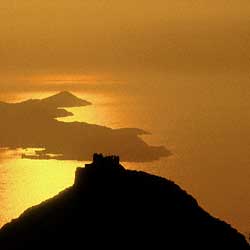 The
largest island in the Tuscan Archipelago is Elba, which has beaches,
inlets, rocky coastline, green hills, Mediterranean macchia vegetation,
and woods. Already mentioned in Greek and Roman times, it was ruled
by the Pisans and Genoese, and later formed part of the Principato degli
Appiani, the overlords of Piombino. It is perhaps best known for
Napoleon Bonaparte's stay there from 1814 to 1815; together with
Pianosa and Palmaiola, Elba constituted for a brief period
the small kingdom conceded to Napoleon in return for his abdication.
He ruled the island for ten months, initiating a variety of public works,
building roads, and developing the mines of Rio and the granite quarries.
Important work was also done to provide sources of drinking water. After
the final fall of Napoleon, Elba became part of the Grand Duchy of Tuscany
and, from 1860 onwards, the Kingdom of Italy. The
largest island in the Tuscan Archipelago is Elba, which has beaches,
inlets, rocky coastline, green hills, Mediterranean macchia vegetation,
and woods. Already mentioned in Greek and Roman times, it was ruled
by the Pisans and Genoese, and later formed part of the Principato degli
Appiani, the overlords of Piombino. It is perhaps best known for
Napoleon Bonaparte's stay there from 1814 to 1815; together with
Pianosa and Palmaiola, Elba constituted for a brief period
the small kingdom conceded to Napoleon in return for his abdication.
He ruled the island for ten months, initiating a variety of public works,
building roads, and developing the mines of Rio and the granite quarries.
Important work was also done to provide sources of drinking water. After
the final fall of Napoleon, Elba became part of the Grand Duchy of Tuscany
and, from 1860 onwards, the Kingdom of Italy.
The capital of the island is Portoferraio, which is situated on
a natural promontory and has good ferry connections with Piombino,
Livorno, and the other islands of the archipelago. It has always made
an excellent port, a fact which favoured the early Ligurian and
Etruscan settlers. In the medieval period it was a modest-sized town and
went by the name of Ferraio; in 1548, it was purchased by Cosimo I who
had it totally reconstructed according to a military plan. Forte Stella
(later Napoleon's headquarters), Forte Falcone, and the Bastione e Torre
della Linguella were built to defend this important trading port.
There are a number of interesting places to visit on the island. There
is the Palazzina Napoleonica (also called Palazzina dei
Mulini), built a hundred years before Napoleon's arrival; its external
appearance gives no hint of the riches inside, and together with
the Villa di San Martino it forms the Museo Nazionale delle Residenze
Napoleoniche. Also of interest are the Medici bastions built
by Buontalenti. Other small towns in Elba are Rio dell'Elba,
Rio Marina, Porto Azzurro, Capoliveri, and Marciana.
Since ancient times the island has produced both red and white wine.
The smaller islands of the Tuscan Archipelago offer continually
changing landscapes of sea and Mediterranean macchia. The northernmost
and smallest island is Gorgona, which was settled by the Etruscans,
then by the Romans, and over the centuries that followed there were also
various monasteries there. Finally, in 1406, following a period of Pisan
rule, it came under the control of the Medici who built a fort there.
Capraia, which is Roman in origin, is an oval-shaped volcanic island
with a high coastline and lots of caves. It is dominated by the Fortezza
di San Giorgio, which was erected by the Genoese at the beginning
of the 15th century. The island's dense vegetation includes some
extremely rare species and consists essentially of Mediterranean
macchia; in the past there also used to be wild goats (hence the island's
name: capra=goat) and seals on the island.
Pianosa is the island closest to Elba, so named because it is
flat (piano=flat) Like Elba, it was under various different dominions
until it fell under the control of the Grand Duchy of Tuscany. In 1858,
it became a penal colony. The remains of a luxurious Roman villa, partly
submerged beneath the sea, have been found here.
Montecristo (originally called Artemisia), 40 kilometres from Elba,
consists of a single granite mass rising to three peaks.
A Benedictine monastery was founded on the island, but it was abandoned
in 1553 after being ransacked by the corsair Dragut. The wealth
taken to the mainland gave rise to a legend of treasure buried by the
monks, which was inspiration for Alexander Dumas in The Count
of Montecristo. Since 1989, Montecristo has been part of the
Parco Nazionale dell'Arcipelago Toscano, and the only form of access
is by guided visit. The number of people who can visit the island
annually is one thousand.
Picture by Sandro Santioli
|